PROBLEM 7: Kim or Kanye?
Source: Shaffer & Kipp, Berk
Defining Sex and Gender
Sex: a person’s biological identity
His or her chromosomes, physical manifestations of identity and hormonal influences
Gender: a person’s social and cultural identity as male or female
Gender Typing: process by which a child becomes aware of his/ her gender and acquires
motives, values, and behaviors considered appropriate for members of that sex.
Gender-role Standard:
Behavior, value or motive that members of a society consider more typical or appropriate for
members of one sex.
- Expressive role: social prescription, (usually directed towards females) that one
should be cooperative, kind, nurturant and sensitive to needs of others
- Instrumental role: social prescription (usually directed towards males) that one should
be dominant, independent, assertive, competitive and goal oriented.
Sex Differences
PSYCHOLOGICAL DIFFERENCES
Verbal Ability:
- girls have greater verbal abilities, acquire language and develop verbal abilities at
an earlier age.
- Advantage in reading comprehension and speech fluency
- Boys perform slightly better on tests of verbal analogies
Visual/ spatial Abilities:
- Ability to manipulate or infer about info in a picture
- Boys outperform girls but not by much difference
- Detectible at 4 years and throughout life
Mathematical Ability:
- Boys show advantage over girls with regards to arithmetic reasoning
- Girls exceed boys in computational skills and even get higher grades in math
- Girls are more included that boys to adopt learning rather than performance goals
, Aggression:
- Boys more physically and verbally aggressive than girls (starting at 2)
- 10x more likely than girls to be antisocial, involved in violent crime
- Girls more likely to be hostile towards others by snubbing/ ignoring them or
trying to undermine their relationships or social status
Activity Level:
- Boys more active than girls (before birth-childhood)
Fear, Timidity, Risk Taking:
- 1st year of life – girls more fearful/ timid, more cautious and assertive, take less
risks
- Sex differences stem from boys heightened activity levels
- Mothers of 6-10 year old’s report they try harder with daughters than with sons to
enforce rules against risk taking because they have had less success at modifying
sons risky behavior and have concluded that “boys will be boys” and it is “in their
nature”
Developmental Vulnerability:
- Boys more physically vulnerable than girls to prenatal and perinatal hazards
- Boys more likely to display developmental problems (autism, reading disabilities,
speech defects, attention-deficit and developmental delays in cognitive abilities)
Emotional Expressivity/ Sensitivity:
- Infants do not differ
- Toddlerhood, boys are more likely to display anger and girls display most other
emotions
- Both express facial distress, concern and physiological arousal to others
misfortunes
Compliance:
- Girls more compliant with requests and demands from parents, teachers, authority
figures
- When trying to get others to comply- girls rely on tact and polite suggestions
- Boys more likely to resort to demanding or controlling strategies
Self-esteem:
- boys show better self-esteem than girls
- sex differences noticeable in early adolescence and lasts throughout adulthood
Cultural Myths






